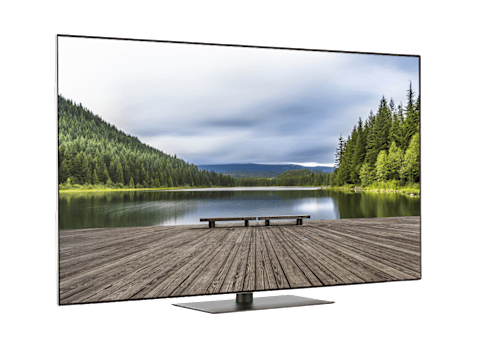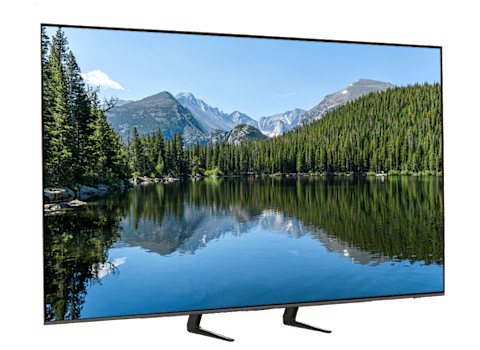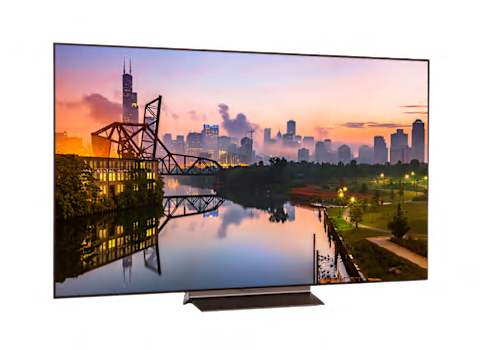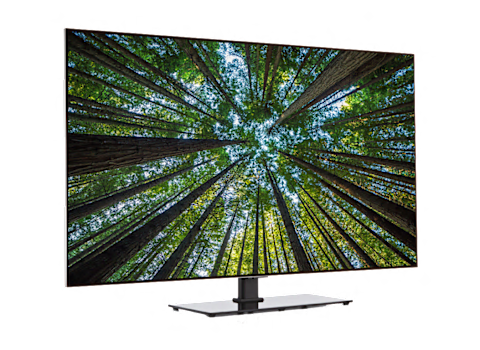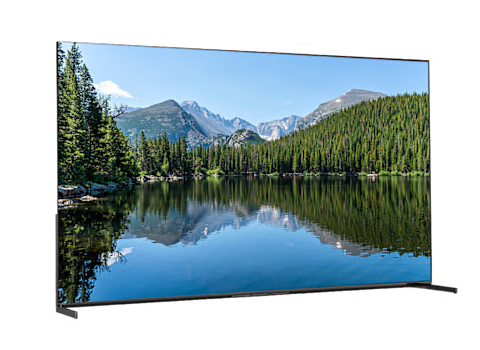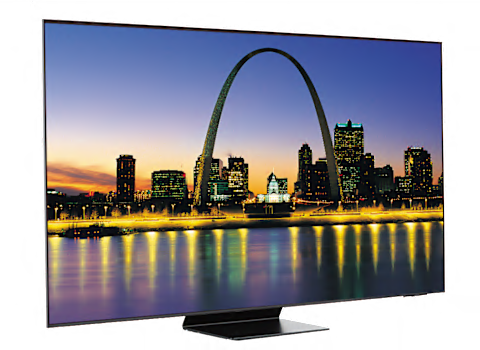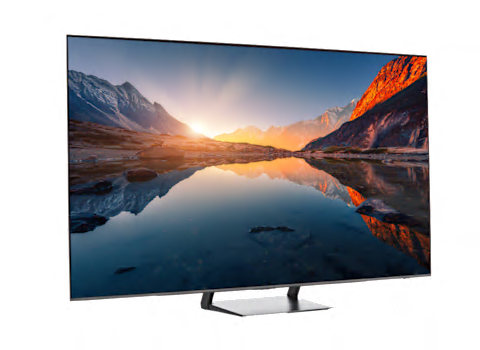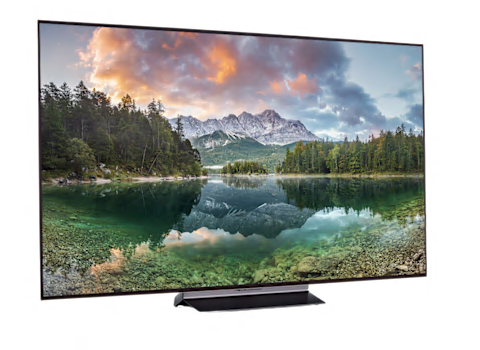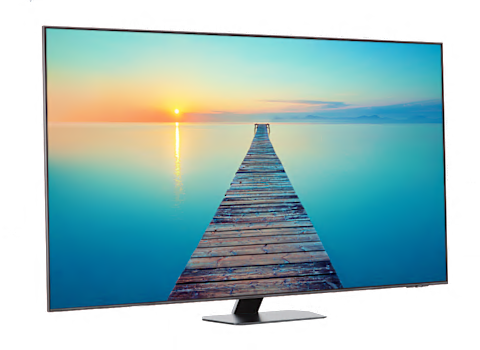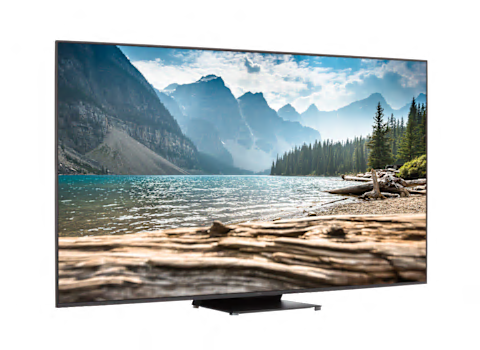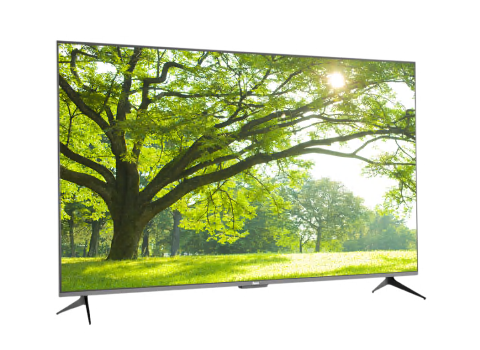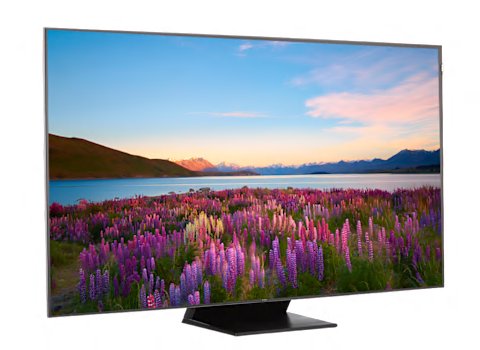15 Best TVs of 2024, Tested by Our Experts
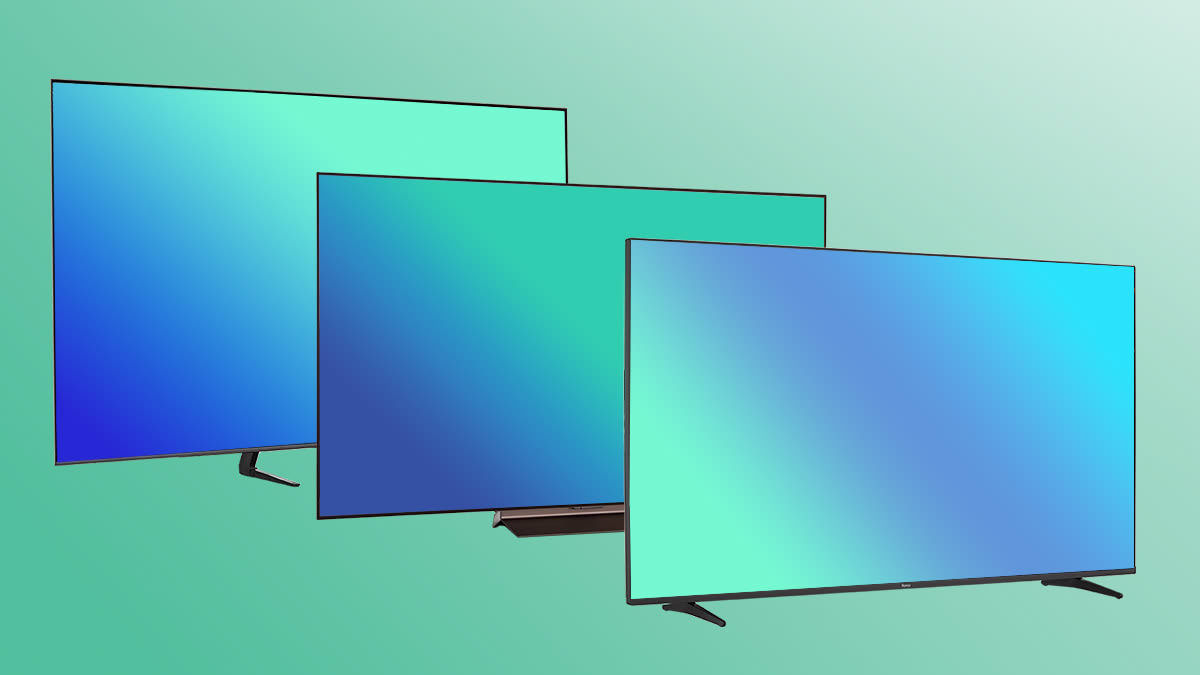
CR tests hundreds of TVs each year. These 4K sets from Hisense, LG, Roku, Samsung, Sony, and TCL deliver great picture quality.
OLED sets from Samsung (left) and Sony (center), plus a new Pro series QLED TV from Roku are among CR’s top picks.
By James K. Willcox
This is one of the best times of the year to get a new big-screen TV, with screens 65 inches and larger becoming more common—and less expensive—than just a year ago.
But prices can vary widely right now, depending on everything from promotional activity to inventories. In addition to newer 2024 sets, many of which are at their lowest prices so far this year, we still see a fair number of leftover 2023 sets for sale. Many of these previous-year TVs can deliver top-notch picture quality, so it’s worth considering them.
Below, we list the best TVs you can buy right now, based on CR’s extensive lab tests. Keep checking back because we’re continuing to evaluate new TVs as they come on the market. CR tests hundreds of TVs each year.
Below, we’re spotlighting sets with 65-inch screens. You can also find smaller, less expensive versions of most of these models, and most are also available in even bigger screen sizes.
The best TVs in CR’s testing tend to be pricier flagship models. But for people who want to spend less, we’ve also included some great sets that perform almost as well as the top models but cost $1,000 or less. (Information on specific models, along with our full TV ratings, is available to CR members.)
At this time of year, prices are changing fairly regularly, especially on new 2024 models. So it pays to see whether a retailer offers a 30-day price guarantee, which will help protect you against price drops in the weeks after you’ve made your purchase.
Best TVs Overall
You can’t go wrong with any of these top-performing TVs. They offer top-notch overall picture quality, a great high dynamic range experience, and either very good or excellent sound. Even models with slightly lower Overall Scores still have top picture quality and HDR scores, but they may have earned lower marks in areas such as viewing angle or sound quality. (You can improve the sound on almost any TV by adding a soundbar.)
LG OLED65G4SUB
The LG OLED65G4SUB is LG’s flagship 4K OLED TV for 2024, and it’s among the best TVs you can buy. Thanks to its new microlens array (MLA) technology, which LG calls Brightness Booster Max, it’s the brightest LG OLED we’ve tested. This set earns top scores for overall picture quality as well as HDR performance; it also has excellent sound. For gamers, the set supports 4K 144-hertz refresh rates, ALLM, and VRR. Unlike last year’s G3 sets, the 55- and 65-inch G4 models come with a stand. Also, this year no LG sets will include an ATSC 3.0 tuner because of a licensing issue.
Samsung QN65S90D
The Samsung QN65S90D, a QD OLED set positioned just below the company’s flagship series for 2024, delivers excellent overall picture quality as well as HDR performance. It also has excellent sound. It has a new AI processor, and for gamers, the set supports 4K 144-hertz refresh rates, as well as ALLM and VRR. A new gaming feature, called Auto AI mode, automatically adjusts the picture based on the genre of game it detects. Samsung TVs support HDR10, HDR10+, and HLG HDR formats, but not Dolby Vision. One unusual aspect of Samsung’s 2024 S90D lineup (and S90DD models, sold in warehouse clubs) is that it uses two different OLED TV technologies, QD-OLED and WOLED, depending on screen size. Based on what we’ve seen, the 55-, 65-, and 77-inch models use QD-OLED panels, while the 42-, 48-, and 83-inch sets use WOLED panels.
LG OLED65C4PUA
The LG OLED65C4PUA, a model below the company’s flagship set in its 4K OLED TV lineup for 2024, offers the best balance of price and performance among LG’s 2024 OLED TVs. It has many of the features you get with the G4 sets—including the updated AI processor and 144-hertz gaming—but the screen doesn’t get quite as bright. But it aces our picture quality tests, it’s able to present a top-notch HDR experience, and it has great sound. The LG OLED65C4AUA performs similarly, but is sold via warehouse clubs.
LG OLED65G3PUA
The LG OLED65G3PUA is in the company’s flagship G3 series from 2023. It was LG’s brightest OLED TV last year, thanks to microlens array (MLA) technology, which LG calls Brightness Booster Max. This set earns top scores for overall picture quality as well as HDR performance; it also has very good sound. The TV includes an ATSC 3.0 tuner for receiving Next-Gen TV broadcast signals through an antenna as the technology rolls out across the country. (The 2024 models lack the ATSC 3.0 tuner because of a licensing dispute.)
Sony XR-65A95L
The Sony XR-65A95L was Sony’s flagship OLED TV for 2023, and it’s been carried over for 2024. It remains one of the best sets you can buy. It uses the newer QD-OLED technology, employs quantum dots for color, and, like other Sony TVs, has the Google TV smart system with the voice-enabled Google Assistant built-in.
Samsung QN65S95D
The Samsung QN65S95D—in the company’s flagship OLED TV series for 2024—delivers top-notch picture quality and great HDR performance. It also has a 4.2.2-channel sound system that supports Dolby Atmos audio. Other features include an anti-reflective screen, built-in support for Bixby and Amazon Alexa voice assistants, several gaming features (including 4K, 144Hz VRR), and Samsung’s Q-Symphony sound, which lets you use the speakers in the TV and a Samsung soundbar together. The set comes with a solar-cell remote that can charge using your home’s lighting. The Samsung QN65S95DD performs similarly, but is sold via warehouse clubs.
Samsung QN65S90C
The Samsung QN65S90C, a QD OLED set just below the company’s flagship series for 2023, delivers top-notch overall picture quality as well as HDR performance. It also has very good sound—better, in fact, than Samsung’s flagship model that year. It includes an ATSC 3.0 tuner for receiving Next-Gen TV signals through an antenna as they become available across the U.S. The Samsung QN65S90CD set is similar but sold via warehouse clubs.
LG OLED65C3PUA
The LG OLED65C3PUA is a midtier 2023 OLED TV that’s sold through electronics stores and mass merchants. (The LG OLED65C3AUA is a similar TV that’s sold in warehouse clubs.) This set has excellent overall picture quality, but its HDR performance, while very good, is just a bit below that of the flagship G3 sets. It’s well-priced for a TV that delivers this level of performance.
Sony K-65XR80
The Sony K-65XR80, also known as the Bravia 8, is a 2024 OLED TV that offers excellent overall picture quality and an effective HDR experience. It also has great sound. Unlike the flagship A95L model that’s being carried over for 2024, this set uses a conventional WOLED panel rather than a QD-OLED panel. Like all Sony TVs, this uses the Google TV smart system with built-in Google Assistant.
Samsung QN65QN90D
The Samsung QN65QN90D, the brand’s flagship 4K Neo QLED TV for 2024, is the only LCD/LED TV in this top tier of TVs. It offers excellent overall picture quality, a great HDR experience, plus very good sound. It also has a wider-than-average viewing angle for an LCD-based set. Like other Neo QLED models, it includes a Mini LED backlight and uses quantum dots for an expanded range of colors. It comes with Samsung’s solar-powered remote.
Best 65-Inch TVs for Under $1,000
The best TVs tend to be pricey, but there are some really good performers that cost less than $1,000. The eight models listed below prove that point. All deliver very good to excellent overall picture quality, and half can deliver a satisfying HDR experience. The list is a mix of 2023 sets and 2024 models. All of the leftover models offer a great viewing experience at a more modest price.
Roku 65R8B5/65R8BX
The Roku 65R8B5/65R8BX is in Roku’s new flagship Pro-series of QLED TVs for 2024, situated above the Plus models in the lineup. Its high-end features include a 120-hertz panel, quantum dots, and Mini LED backlights. A setting called Roku Smart Picture uses AI to automatically adjust the TV’s picture based on the content that’s being played. It supports both Dolby Vision IQ HDR and Dolby Atmos sound. In our tests, it has very good overall picture quality and the best HDR performance we’ve seen from a Roku-made model. It also has very good sound and a wider-than-average viewing angle for an LCD set.
TCL 65QM850G
The TCL 65QM850G, the company’s flagship model for 2023, offers a lot for the money, including very satisfying overall picture quality and top-notch HDR performance. In 2023, the QM8 sets were the only TCL TVs to get Mini LED backlights. This year, more sets are being built with this feature.
Hisense 65U8K
The Hisense 65U8K offers very good overall picture quality, top-notch HDR performance, and very good sound. Like other 2023 ULED sets, it has a Mini LED backlight with even more local dimming zones than its predecessor, and it supports up to 144-hertz gaming. It’s a Google TV.
Roku 65R6A5R
The Roku 65R6A5R, a midtier 2023 model in the company’s Roku Plus series actually made by Roku, offers a lot for the money, including top-notch overall picture quality. For HDR performance, though, it falls below the best models in this under-$1,000 group, including Roku’s own upper-tier Pro model.
TCL 65QM751G
The TCL 65QM751G is a mid-tier set in TCL’s 2024 QLED lineup. In CR testing, it does very well for overall picture quality and even better for HDR, thanks to very high brightness. Like the QM851-series models above it, the set uses a Mini LED backlight with local dimming, which can help improve contrast and black levels.
LCD TVs vs. OLED TVs
Before you decide on a new set, it pays to understand the two basic technologies used in today’s televisions. LCD TVs (also called LED TVs) have LED backlights that illuminate the screen, while in OLED TVs, each pixel generates its own light.
OLED sets do a great job of displaying the blackest parts of an image, so the deepest shadows can really look black, as in real life, rather than gray. OLED TVs also have essentially unlimited viewing angles, so the picture still looks great even if you’re not viewing the screen head-on.
In 2022, Samsung and Sony introduced a new type of OLED TV, called QD-OLED, that can produce a brighter overall image than older OLED sets. Now LG, which uses a different type of OLED, called WOLED, is using another newer technology, called MLA (microlens array), in its flagship G-series set. MLA uses millions of tiny mirrors to boost brightness in its best WOLED models.
But most TVs are LCD sets. While they generally can’t deliver OLED-like black levels, they get better every year, especially models that use full-array backlights, where the LEDs are spread across the entire rear panel instead of just along the edges. These models include a feature called local dimming, which divides the backlights into zones that can be dimmed or illuminated separately, depending on the scene. This can help improve black levels.
Some newer sets have Mini LED backlights, which use a large number of even smaller LEDs that can be divided into more zones and locally dimmed. We’ve found that Mini LEDs can help improve contrast and black levels, and reduce halos around the edges of bright objects displayed against a dark background.
Typically, only pricier TVs have full-array backlights with local dimming. Other sets are edge-lit, with the LEDs positioned on the sides of the screen. Some of these sets also include local dimming, but it tends to be less effective than in sets with full-array backlights. The best LCD TVs can create very bright, vivid images.
How CR Tests TVs
The TV test team at Consumer Reports puts every TV through a battery of tests in our TV labs. We first set up each TV and carefully note all of its key features, such as resolution, the number of HDMI inputs, and support for streaming services and voice-enabled digital assistants. We then set up the TV for optimal performance using the set’s built-in presets and picture controls, just like you would. We use objective tests and measurements, as well as real-world video clips and subjective evaluations, to determine picture detail, color accuracy, and contrast, and compare each TV with one of several fully calibrated reference TVs in our labs.
HDR, short for high dynamic range, is now found in a vast majority of midsized to large sets. HDR increases the contrast between the brightest whites and the darkest blacks a TV can produce. To do a good job with HDR video, a TV needs to get bright enough to display brighter, more colorful images with greater contrast and a wider array of colors, much closer to what we see in real life.
For HDR performance, we measure the TV’s peak brightness using a $40,000 Photo Research PR-740 spectroradiometer (also used for fine colors and deep black measurements) and industry standard and proprietary test patterns. We then evaluate the TV’s HDR performance with both very dark and very bright scenes, as well as with video clips that feature an extended range of colors.
We evaluate picture quality for clarity, color accuracy, and contrast at various horizontal and vertical viewing angles. Motion-blur tests, done at various speeds, are an evaluation of how well the TV can produce a blur-free image during motion scenes.
Sound quality is evaluated using the TV’s built-in speakers in subjective testing by a trained listening panel, with support from audio test equipment. In our judgments, we listen for the overall quality of sound, depth of bass, effective volume levels, and audible distortion during dialogue, music, and movie soundtracks. (Many TVs have disappointing sound in comparison to their image quality. You can address that by adding a soundbar.)
The versatility score is a measure of a TV’s useful features, including access to streaming services, the ability to work with digital voice assistants, the number of HDMI and USB inputs, and support for various media.
Finally, Consumer Reports also includes data privacy and security scores for all the TVs we test. Now that TVs routinely connect to the internet, data privacy and security have become concerns for consumers.
Consumer Reports evaluates the various ways TV brands collect, use, and share consumer data, how well they protect it, and how transparent they are about their data practices. We encourage TV makers to ship their sets to consumers with the optimal privacy settings turned on by default. You can adjust the settings yourself.
Consumer Reports is an independent, nonprofit organization that works side by side with consumers to create a fairer, safer, and healthier world. CR does not endorse products or services, and does not accept advertising. Copyright © 2024, Consumer Reports, Inc.
Source link


